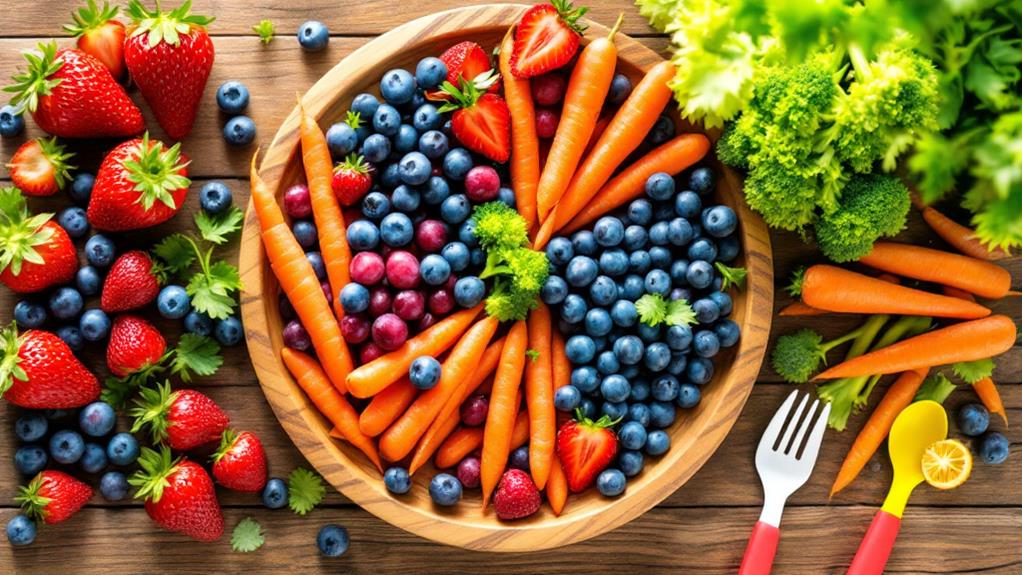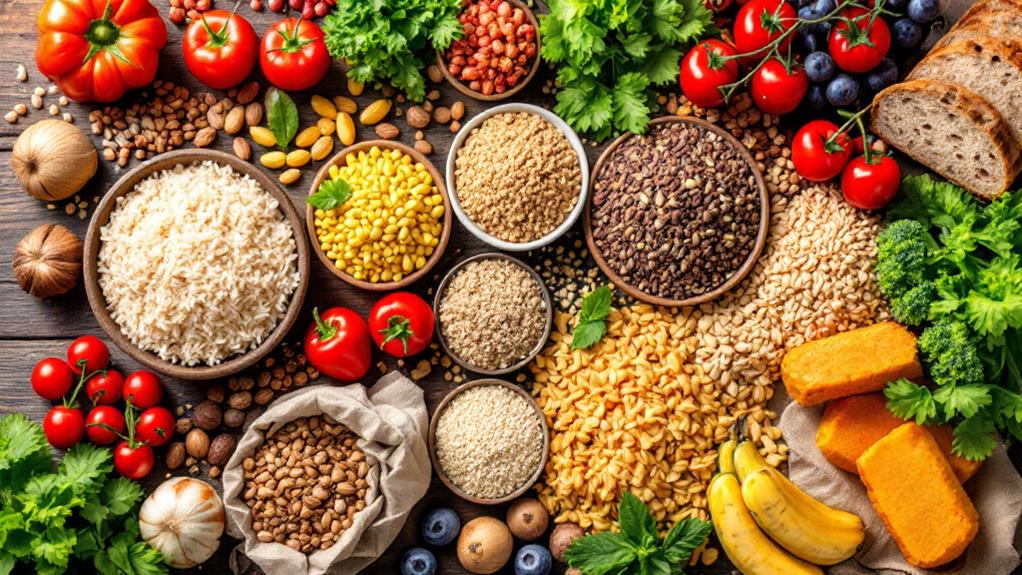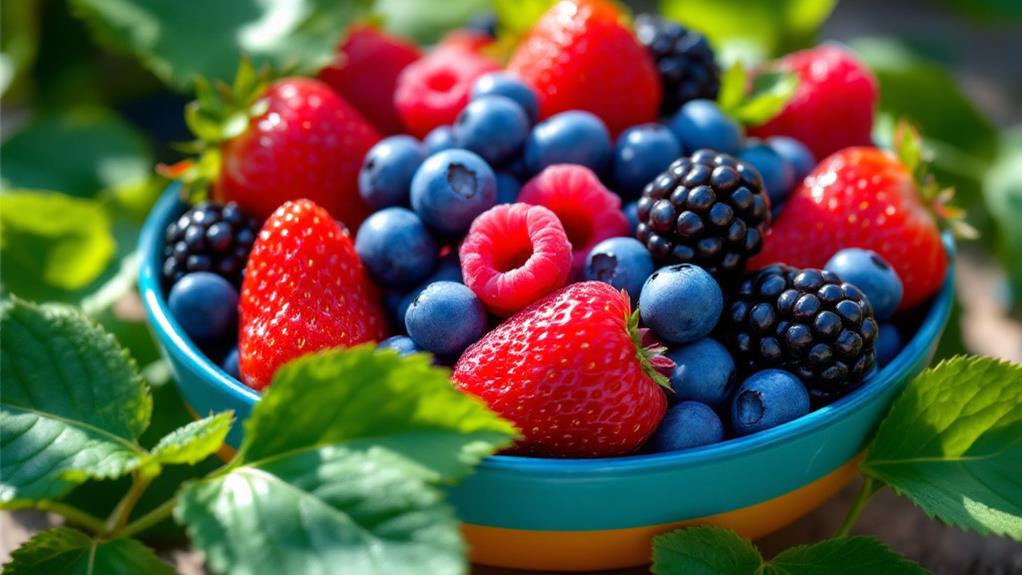What Are the Healthiest Foods for Kids?

The healthiest foods for kids include yogurt, eggs, milk, beans, whole grains, fruits like berries and avocados, and plenty of colorful vegetables. Yogurt and milk are packed with calcium and protein for strong bones. Eggs provide crucial nutrients and are great for brain development. Beans and whole grains are high in fiber, keeping kids full and aiding digestion. Berries offer antioxidants, while avocados supply healthy fats for heart health. Including a variety of these foods in your child's diet helps support their growth and development. There's more to uncover about making these choices fun and appealing!
Nutritional Benefits of Yogurt
Yogurt is one of the healthiest foods you can include in your child's diet. It's packed with protein, which is vital for growth and development. Choosing plain Greek yogurt gives you even more protein without any added sugars, making it a smart choice. Plus, yogurt is a fantastic source of calcium, important for building strong bones and teeth. With the added benefit of vitamin D, yogurt helps improve calcium absorption, ensuring your child gets the most from their food. Moreover, yogurt is a nutrient-dense option that can be easily incorporated into different meals and snacks.
One of the standout features of yogurt is its probiotics. These good bacteria promote a healthy gut, aiding digestion and overall gut health. Including yogurt in your child's meals can greatly increase their nutrient intake, fitting perfectly into a healthy diet.
You can easily serve yogurt plain, mix it with fruits, or use it in delicious recipes like smoothies or frozen yogurt pops. A recommended serving size for children is around 6 to 8 ounces, making it a simple way to help meet their daily calcium and protein needs. By incorporating yogurt into their diet, you're giving your child a nutritious, tasty option that supports their growth and total health.
Importance of Eggs
In regard to nutritious options for your child, eggs stand out as a powerhouse food. They're packed with high-quality protein, with one large egg containing about 6 grams, fundamental for your child's growth and development. Eggs are also rich in important vitamins and minerals, including vitamin D, B12, and iron, which play significant roles in healthy bone development and cognitive function. Moreover, getting enough sleep is fundamental for your child's overall health, as it supports growth and cognitive performance, helping them absorb the nutrients from foods like eggs more effectively increases productivity and focus.
You'll be glad to know that fortified eggs can provide extra omega-3 fatty acids, further supporting brain development and overall health. This makes eggs a versatile option that can be introduced to babies when they're ready for solids, offering a nutritious start from an early period.
While there's been concern about cholesterol, recent research shows that the cholesterol in eggs has minimal impact on blood cholesterol levels, especially compared to the effects of saturated and trans fats. So, incorporating eggs into your child's diet can be a healthy choice without the worry.
With their combination of protein, fundamental vitamins and minerals, and omega-3 fatty acids, eggs are not only delicious but also a nutritious supplement to your child's meals.
Advantages of Milk

Why is milk often considered a staple in children's diets? It's packed with indispensable nutrients that support their comprehensive health and development. Milk is an excellent source of calcium and vitamin D, which are essential for building strong bones and teeth in kids. Just one 8-ounce glass provides about 30% of their daily calcium requirement.
Each serving of milk contains around 8 grams of protein, crucial for growth and muscle development. For children under 2 years old, whole milk is recommended because it offers healthy fats necessary for brain development and overall growth. These healthy fats play a key role in cognitive function during those early years.
If you're considering alternatives, be mindful that options like almond or soy milk can vary markedly in nutrient profiles. Always choose unsweetened varieties that are fortified with calcium and vitamin D to guarantee your child gets the benefits they need. Including milk in your child's diet can help set them up for a healthy future, making it a fantastic and nutritious choice.
Fiber-Rich Beans
Beans are a powerhouse of nutrition, making them a fantastic supplement to your child's diet. These fiber-rich beans are packed with protein and fiber, with a single cup of cooked black beans offering about 15 grams of each. This high fiber content supports digestive health and helps your children to eat well while feeling full and satisfied. For kids between 4-8 years, the recommended daily fiber intake is around 25 grams, and incorporating beans into meals can help meet this goal.
Low-sodium canned options, like chickpeas or kidney beans, are convenient and versatile. You can easily toss them into salads, soups, or casseroles. Replacing meat with beans not only maintains protein quality but also elevates the fiber content, enhancing diet quality for active children. Plus, the fiber in beans helps regulate blood sugar levels, keeping energy levels steady and preventing mood swings throughout the day.
Consider serving beans as healthy snacks or adding them to your family's favorite dishes. By including fiber-rich beans in your meals, you're promoting healthy foods that contribute to your child's comprehensive well-being.
Healthy Whole Grains

Whole grains are a vital part of a healthy diet for kids, providing significant nutrients that support their growth and development. Foods like brown rice, quinoa, and whole wheat bread are packed with necessary fiber, vitamins, and minerals. Including these whole grains in your child's meals can greatly enhance their energy levels and help maintain healthy eating habits.
One of the key benefits of whole grains is their high fiber content. For kids between 4-8 years, the daily recommended intake is around 25 grams of fiber. Incorporating whole grains into their diet can help meet this requirement, ensuring they feel fuller longer. This fullness can be beneficial in maintaining a healthy weight and preventing overeating.
Whole grains are incredibly versatile, easily added to breakfast cereals, lunch sandwiches, or dinner side dishes. By choosing whole grain options over refined grains, you're not only improving your child's nutritional intake but also contributing to long-term health benefits. So next time you shop, look for whole grains to support your child's growth, energy, and general well-being.
Benefits of Avocado
Incorporating healthy fats into your child's diet is just as crucial as including whole grains. Avocados are an excellent source of monounsaturated fats, which not only benefit heart health but also help reduce inflammation in kids. Their fiber content supports digestive health and keeps children feeling full longer, making weight management easier.
As a nutrient-dense food, avocados provide important vitamins and minerals, including potassium, vitamin E, and B vitamins, all necessary for growth and development. Their creamy texture makes them incredibly versatile; you can spread them on toast, blend them into smoothies, or toss them in salads. This adaptability means you can create healthy meals that your child will enjoy.
Moreover, avocados can help promote healthy eating habits. Their mild flavor appeals to picky eaters, making it easier for you to include more fruits and vegetables in your child's diet. By regularly serving avocados, you not only introduce a delicious option but also encourage your child to welcome nutritious foods. Adding this superfood to your family's meals can pave the way for a healthier lifestyle and better food choices in the long run.
Nutritional Power of Berries

Regarding enhancing your child's nutrition, berries are a powerhouse choice. Packed with antioxidants, vitamins, and fiber, these fruits offer significant support for children's immune systems and general health. They're naturally low in calories and sugar, making them a fantastic snack option. For instance, a cup of strawberries contains only about 50 calories and 7 grams of sugar, so you can feel good about offering them.
You can easily incorporate berries into different meals, increasing both flavor and nutrition. Try mixing them into yogurt, tossing them in smoothies, or adding them to oatmeal. Not only do they taste great, but the fiber content in berries also aids digestion and promotes satiety. For example, a cup of raspberries provides about 8 grams of fiber, helping your kids feel full longer.
Regular consumption of berries has been linked to improved cognitive function and a reduced risk of chronic diseases. By including these nutritious fruits in your child's diet, you're fostering lifelong healthy eating habits that can set them up for success. So, make berries a staple in your kitchen today!
Essential Vegetables
In relation to building a healthy plate for your kids, important vegetables should be a top priority. Incorporating a variety of vegetables not only makes meals colorful but also guarantees your children get fundamental vitamins and minerals necessary for their growth and development. Dark leafy greens like spinach and kale are particularly advantageous, packed with iron and calcium to support bone health and cognitive function.
Carrots are another fantastic choice, rich in beta carotene, which your child's body converts to vitamin A. This nutrient is crucial for maintaining good vision and improving immune function. Don't forget about bell peppers, especially the red ones, which are loaded with vitamin C to help strengthen their immune system and promote healthy skin.
Encouraging Healthy Eating

Getting kids excited about healthy eating goes hand in hand with the vegetables you've already introduced. One of the best ways to encourage them to eat healthy foods is to involve them in meal planning and preparation. When kids help choose and make meals, they feel a sense of ownership over their eating choices, making them more likely to try new foods.
Make fruits and vegetables visually appealing by using creative shapes or engaging presentations. You can transform a simple fruit salad into a rainbow masterpiece, which might spark their curiosity to taste. As a parent, model healthy eating behaviors; kids often mimic what they see at home.
Also, limit access to unhealthy snacks. By making healthy options readily available, you entice them to snack wisely. Ultimately, create a positive mealtime environment. Incorporate games or storytelling to make meals enjoyable, reducing anxiety around eating.




